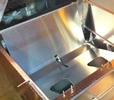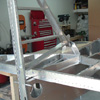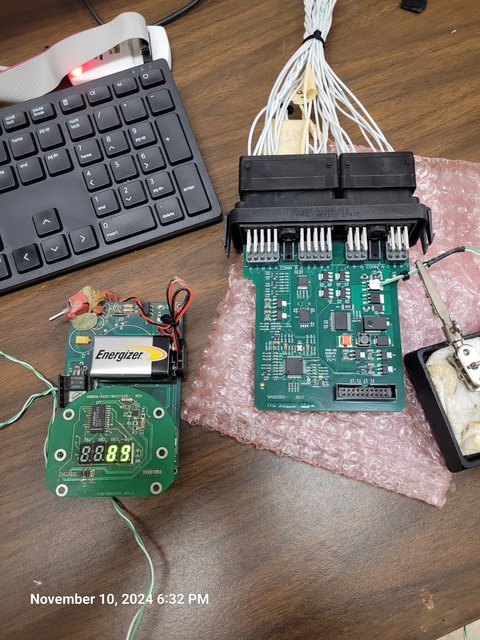


random user submitted photo
The VeeCU
Re: The VeeCU
Hi Guys,
Lots of distractions lately but ..., some progress.
I ported the software from the bread board to the prototype. I hooked up the prototype to Frankenpanel.

Frankenpanel allows me to drive either LEDs, for software development, or actual coils and injectors, for hardware testing.
I chose the enclosure I did largely to keep cost in check. One price paid for using a plastic enclosure is reduced heat dissipation. So, I've been worried about how hot it was going to get in the enclosure while operating. I couldn't resist running a quick check just to see. I ran the unit very hard to see if I had a problem or not.
14 Volts
3 Ohm Coils
Constant Dwell of 12 mSec.
4000 RPM
65.9 Injector Duty Cycle
10.16 GPH calculated Fuel Flow. (I had MAP and Mixture way up).
4.3 Amps Total.
20 Deg. C. Temperature rise internal.
Every component of the VeeCU is rated for at least 120 Deg. C operation. Seems like it's going to be just fine.
I have some thermally conductive glue on order. It should be here tomorrow. I'll glue a very small thermocouple to the ignition switching transistors and see how hot they are getting. They are rated for 175 Deg. C. operation but I don't want to see them anywhere near that.
Much more testing to follow.
Wes
Lots of distractions lately but ..., some progress.
I ported the software from the bread board to the prototype. I hooked up the prototype to Frankenpanel.

Frankenpanel allows me to drive either LEDs, for software development, or actual coils and injectors, for hardware testing.
I chose the enclosure I did largely to keep cost in check. One price paid for using a plastic enclosure is reduced heat dissipation. So, I've been worried about how hot it was going to get in the enclosure while operating. I couldn't resist running a quick check just to see. I ran the unit very hard to see if I had a problem or not.
14 Volts
3 Ohm Coils
Constant Dwell of 12 mSec.
4000 RPM
65.9 Injector Duty Cycle
10.16 GPH calculated Fuel Flow. (I had MAP and Mixture way up).
4.3 Amps Total.
20 Deg. C. Temperature rise internal.
Every component of the VeeCU is rated for at least 120 Deg. C operation. Seems like it's going to be just fine.
I have some thermally conductive glue on order. It should be here tomorrow. I'll glue a very small thermocouple to the ignition switching transistors and see how hot they are getting. They are rated for 175 Deg. C. operation but I don't want to see them anywhere near that.
Much more testing to follow.
Wes
Wes Ragle
Onex #89
Conventional Gear
Long Tips
Hummel 2400 w/Zenith Carb
Prince P Tip 54x50
First Flight 06/23/2020
42.8 Hrs. as of 10/30/21
Onex #89
Conventional Gear
Long Tips
Hummel 2400 w/Zenith Carb
Prince P Tip 54x50
First Flight 06/23/2020
42.8 Hrs. as of 10/30/21
- WesRagle
- Posts: 894
- Joined: Fri Jan 05, 2018 12:35 pm
- Location: Weatherford, Tx
Re: The VeeCU
Hi Guys,
I received the thermal conductive glue. A long time ago a guy showed me a method for measuring the temperature of an IC. First you get some high quality TC hookup wire. Then form a TC by stripping the wire and clipping off all but one strand of the wire. Next, twist the two strands together tightly and clip off all but the very tip. Put some thermally conductive "stuff" on the IC in question and stick the tip of the wire into it all the way to the surface of the IC. Make sure the strands do not touch outside the thermally conductive stuff.
That's all there is to it. A very responsive TC with very little heat sink effect.

I have an old EGT prototype gauge that I rescued from the trash after a lab clean up at work some 25 years ago. Still works and is very accurate.
To test the ignition transistor temperature rise I decided to go for broke. I hooked up a 3 Ohm Dynatek coil and set the RPMs to 60. At 60 RPM no dwell control is applied/possible so the coil is powered virtually 100% of the time. I intend to rate the VeeCU for operation over a voltage range of 6 to 20 volts so I set the voltage to 20.
I got some results I didn't expect.
At the beginning of the test:
IC Temperature 22 Deg. C.
Coil Resistance 3.0 Ohms.
RPM 60.
Voltage 20.
Current 6 Amps.
During the test peak IC temperature was 90 Deg. C.
At the end of the test:
IC Temperature 81 Deg. C.
Coil Resistance Approximately 5.0 Ohms
Current 3.4 Amps.
I didn't expect that! I have been assured by Dynatek that the coil does not contain a ballast resistor. So I asked Cpt. Google what the "thermal coefficient of resistance for copper" is. It's about 0.4 percent per centigrade degree. You can run the numbers but an increase from 3.0 to approximately 5.0 ohms requires an increase of the order of 200 Deg. C. I knew the outside of the coils got hot but I wouldn't have suspected the primary winding got that hot. I don't know, but that's what it seems like. I've duplicated the results with two different makes of 3 Ohm coils. The 5 Ohm is probably a little low. I couldn't get the power off and the meter leads on the coil fast enough. Once the leads were in place you could see the resistance of the primary drop at about 0.1 Ohm per second. Like I said, not what I expected.
Here are a some more "stabilized" measurements.
RPM 4000
Voltage 20
IC Temp 70
Current 2.15 Amps.
RPM 3000
Voltage 14
IC Temp 52
Current 1.3 Amps
I reduced the Voltage to 6 volts to check the spark with a hot coil. At 6 volts the spark duration was 0.75 mSec.
I also checked a hot coil at idle and 14 volts.
RPM 950
Voltage 14
IC Temp 36
Current 0.45 Amps
Injector was about 0.14 A (MAP 500 mBar, Duty 5.5, Calculated FF .816 GPH)
So for a hot coil at Idle total current draw = (2 x 0.45) + 0.14
or about 1.1 Amp.
I'll test a 5 Ohm coil soon.
Live and Learn,
Wes
I received the thermal conductive glue. A long time ago a guy showed me a method for measuring the temperature of an IC. First you get some high quality TC hookup wire. Then form a TC by stripping the wire and clipping off all but one strand of the wire. Next, twist the two strands together tightly and clip off all but the very tip. Put some thermally conductive "stuff" on the IC in question and stick the tip of the wire into it all the way to the surface of the IC. Make sure the strands do not touch outside the thermally conductive stuff.
That's all there is to it. A very responsive TC with very little heat sink effect.

I have an old EGT prototype gauge that I rescued from the trash after a lab clean up at work some 25 years ago. Still works and is very accurate.
To test the ignition transistor temperature rise I decided to go for broke. I hooked up a 3 Ohm Dynatek coil and set the RPMs to 60. At 60 RPM no dwell control is applied/possible so the coil is powered virtually 100% of the time. I intend to rate the VeeCU for operation over a voltage range of 6 to 20 volts so I set the voltage to 20.
I got some results I didn't expect.
At the beginning of the test:
IC Temperature 22 Deg. C.
Coil Resistance 3.0 Ohms.
RPM 60.
Voltage 20.
Current 6 Amps.
During the test peak IC temperature was 90 Deg. C.
At the end of the test:
IC Temperature 81 Deg. C.
Coil Resistance Approximately 5.0 Ohms
Current 3.4 Amps.
I didn't expect that! I have been assured by Dynatek that the coil does not contain a ballast resistor. So I asked Cpt. Google what the "thermal coefficient of resistance for copper" is. It's about 0.4 percent per centigrade degree. You can run the numbers but an increase from 3.0 to approximately 5.0 ohms requires an increase of the order of 200 Deg. C. I knew the outside of the coils got hot but I wouldn't have suspected the primary winding got that hot. I don't know, but that's what it seems like. I've duplicated the results with two different makes of 3 Ohm coils. The 5 Ohm is probably a little low. I couldn't get the power off and the meter leads on the coil fast enough. Once the leads were in place you could see the resistance of the primary drop at about 0.1 Ohm per second. Like I said, not what I expected.
Here are a some more "stabilized" measurements.
RPM 4000
Voltage 20
IC Temp 70
Current 2.15 Amps.
RPM 3000
Voltage 14
IC Temp 52
Current 1.3 Amps
I reduced the Voltage to 6 volts to check the spark with a hot coil. At 6 volts the spark duration was 0.75 mSec.
I also checked a hot coil at idle and 14 volts.
RPM 950
Voltage 14
IC Temp 36
Current 0.45 Amps
Injector was about 0.14 A (MAP 500 mBar, Duty 5.5, Calculated FF .816 GPH)
So for a hot coil at Idle total current draw = (2 x 0.45) + 0.14
or about 1.1 Amp.
I'll test a 5 Ohm coil soon.
Live and Learn,
Wes
Wes Ragle
Onex #89
Conventional Gear
Long Tips
Hummel 2400 w/Zenith Carb
Prince P Tip 54x50
First Flight 06/23/2020
42.8 Hrs. as of 10/30/21
Onex #89
Conventional Gear
Long Tips
Hummel 2400 w/Zenith Carb
Prince P Tip 54x50
First Flight 06/23/2020
42.8 Hrs. as of 10/30/21
- WesRagle
- Posts: 894
- Joined: Fri Jan 05, 2018 12:35 pm
- Location: Weatherford, Tx
Re: The VeeCU
Hi Guys,
In my last post I got so wrapped up in stressing the system I forgot to answer the basic questions that were on my mind. That is, under normal operating conditions how much power does the system require. So, I got up this morning and took some data under normal operating conditions with cool coils. I also got around to measuring the current requirements of the VeeCU itself.
Results:
0.05 Amps - VeeCU current requirements over 6 to 20 Volts input power range.
Power Requirements at Idle
14 Volts - System Voltage
20 Deg. C. - Initial transistor temperature
31 Deg. C. Final transistor temperature.
950 RPM - Engine Speed
0.5 Amps - Current draw per coil.
0.14 Amps - Injector Current (At FF of 0.825 GPH)
3.0 Ohms - Initial Coil Resistance
3.2 Ohms - Final Coil Resistance
Total Current (2 x 0.5) + 0.14 + 0.05 = 1.19
So, Idle current requirement is about 1.2 Amps + Fuel Pump Current.
Power Requirements at High Cruise
14 Volts - System Voltage
31 Deg. C. - Initial transistor temperature
52 Deg. C. Final transistor temperature.
3400 RPM - Engine Speed
1.7 Amps - Current draw per coil.
0.47 Amps - Injector Current (At FF of 4.15 GPH)
3.2 Ohms - Initial Coil Resistance
3.7 Ohms - Final Coil Resistance
Total Current (2 x 1.7) + 0.47 + 0.05 = 3.92
So, Cruise current requirement is about 4 Amps + Fuel Pump Current.
Edit: I tested the Dynatek 5 Ohm Coil.
Power Requirements at Idle
14 Volts - System Voltage
23 Deg. C. - Initial transistor temperature
30 Deg. C. Final transistor temperature.
950 RPM - Engine Speed
0.3 Amps - Current draw per coil.
0.14 Amps - Injector Current (At FF of 0.825 GPH)
6.0 Ohms - Initial Coil Resistance
6.0 Ohms - Final Coil Resistance
Total Current (2 x 0.3) + 0.14 + 0.05 = 0.79
So, Idle current requirement is about 0.8 Amps + Fuel Pump Current.
Power Requirements at High Cruise
14 Volts - System Voltage
30 Deg. C. - Initial transistor temperature
43 Deg. C. Final transistor temperature.
3400 RPM - Engine Speed
1.0 Amps - Current draw per coil.
0.47 Amps - Injector Current (At FF of 4.15 GPH)
6.0 Ohms - Initial Coil Resistance
6.3 Ohms - Final Coil Resistance
Total Current (2 x 1.0) + 0.47 + 0.05 = 2.52
So, Cruise current requirement is about 2.6 Amps + Fuel Pump Current.
I did look at the spark duration at three voltages for the 5 Ohm Coil.
14 Volts -> 1.25 mSec
8 Volts -> 0.75 mSec
6 Volts -> 0.50 mSec
I have the VeeCU power broken out separately from the Injector and Ignition power for testing. I could reduce the coil voltage below 5 volts before the plugs stopped firing. That is a couple of volts lower that what I measured on the bread board. That's probably due to better switching performance of the IGBTs (ignition transistors) used in the VeeCU vs the evaluation board used in the bread board.
Thanks,
Wes
In my last post I got so wrapped up in stressing the system I forgot to answer the basic questions that were on my mind. That is, under normal operating conditions how much power does the system require. So, I got up this morning and took some data under normal operating conditions with cool coils. I also got around to measuring the current requirements of the VeeCU itself.
Results:
0.05 Amps - VeeCU current requirements over 6 to 20 Volts input power range.
Power Requirements at Idle
14 Volts - System Voltage
20 Deg. C. - Initial transistor temperature
31 Deg. C. Final transistor temperature.
950 RPM - Engine Speed
0.5 Amps - Current draw per coil.
0.14 Amps - Injector Current (At FF of 0.825 GPH)
3.0 Ohms - Initial Coil Resistance
3.2 Ohms - Final Coil Resistance
Total Current (2 x 0.5) + 0.14 + 0.05 = 1.19
So, Idle current requirement is about 1.2 Amps + Fuel Pump Current.
Power Requirements at High Cruise
14 Volts - System Voltage
31 Deg. C. - Initial transistor temperature
52 Deg. C. Final transistor temperature.
3400 RPM - Engine Speed
1.7 Amps - Current draw per coil.
0.47 Amps - Injector Current (At FF of 4.15 GPH)
3.2 Ohms - Initial Coil Resistance
3.7 Ohms - Final Coil Resistance
Total Current (2 x 1.7) + 0.47 + 0.05 = 3.92
So, Cruise current requirement is about 4 Amps + Fuel Pump Current.
Edit: I tested the Dynatek 5 Ohm Coil.
Power Requirements at Idle
14 Volts - System Voltage
23 Deg. C. - Initial transistor temperature
30 Deg. C. Final transistor temperature.
950 RPM - Engine Speed
0.3 Amps - Current draw per coil.
0.14 Amps - Injector Current (At FF of 0.825 GPH)
6.0 Ohms - Initial Coil Resistance
6.0 Ohms - Final Coil Resistance
Total Current (2 x 0.3) + 0.14 + 0.05 = 0.79
So, Idle current requirement is about 0.8 Amps + Fuel Pump Current.
Power Requirements at High Cruise
14 Volts - System Voltage
30 Deg. C. - Initial transistor temperature
43 Deg. C. Final transistor temperature.
3400 RPM - Engine Speed
1.0 Amps - Current draw per coil.
0.47 Amps - Injector Current (At FF of 4.15 GPH)
6.0 Ohms - Initial Coil Resistance
6.3 Ohms - Final Coil Resistance
Total Current (2 x 1.0) + 0.47 + 0.05 = 2.52
So, Cruise current requirement is about 2.6 Amps + Fuel Pump Current.
I did look at the spark duration at three voltages for the 5 Ohm Coil.
14 Volts -> 1.25 mSec
8 Volts -> 0.75 mSec
6 Volts -> 0.50 mSec
I have the VeeCU power broken out separately from the Injector and Ignition power for testing. I could reduce the coil voltage below 5 volts before the plugs stopped firing. That is a couple of volts lower that what I measured on the bread board. That's probably due to better switching performance of the IGBTs (ignition transistors) used in the VeeCU vs the evaluation board used in the bread board.
Thanks,
Wes
Wes Ragle
Onex #89
Conventional Gear
Long Tips
Hummel 2400 w/Zenith Carb
Prince P Tip 54x50
First Flight 06/23/2020
42.8 Hrs. as of 10/30/21
Onex #89
Conventional Gear
Long Tips
Hummel 2400 w/Zenith Carb
Prince P Tip 54x50
First Flight 06/23/2020
42.8 Hrs. as of 10/30/21
- WesRagle
- Posts: 894
- Joined: Fri Jan 05, 2018 12:35 pm
- Location: Weatherford, Tx
Who is online
Users browsing this forum: No registered users and 1 guest







